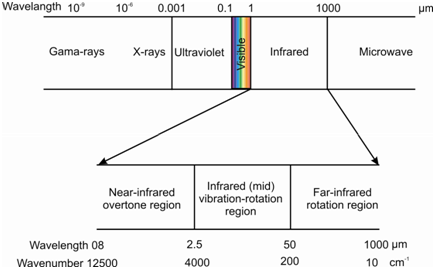Instruments for IR Spectrometry:
Infrared region of the electromagnetic spectrum spreads from the wavelengths of 0.8 to 1000 µm or wave numbers from roughly 12,500 to 10 cm-1. It is bound by the red end of the visible region at lower wavelength end and the microwave region at higher wavelength end. It is addition divided within three regions called near IR, mid IR and far IR regions. The far infrared region (200 cm- 1 to 10 cm-1) is useful for molecules containing heavy atoms such as inorganic compounds and the near IR region (12000 cm-1 to 4000 cm-1) concerns routine quantitative determinations of the simple molecules such as water, CO2 etc. of industrial and agricultural importance. It is the mid infrared region (4,000 cm-1 to 200 cm-1) that is of interest for general chemical analysis purposes.

Figure: Location of IR region in the electromagnetic spectrum
Since it is the mid IR region, which is commonly employed we would like to confine ourselves with the instrumentation of mid IR spectrometers only. Further, we do not intend to take up the detailed working and the construction of an IR spectrometer. We would be contented if you get an impression of the basic principles that lie behind an IR spectrometer. There are three kinds of IR instruments. These are given as below,
- Dispersive infrared spectrometers
- Fourier-transform infrared spectrometers
- Non-dispersive infrared spectrometers